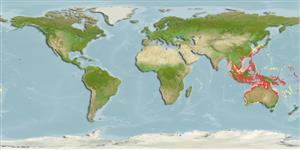分类 / Names
俗名 | 同种异名 | Catalog of Fishes(属, 种) | ITIS | CoL | WoRMS | Cloffa
Environment: milieu / climate zone / depth range / distribution range
生态学
海洋 礁区鱼类; 深度上下限 1 - 55 m (Ref. 37816). 熱帶
Western Pacific: Japan to Australia, including Guam and Palau.
西太平洋: 日本 (參考文獻 559) 到澳洲西北部。
大小 / 重量 / 年龄
Maturity: Lm ? range ? - ? cm
Max length : 30.0 cm TL 雄鱼/尚未辨别雌雄; (Ref. 3132)
背棘 (总数) : 4; 背的软条 (总数) : 8; 臀棘: 0; 臀鳍软条: 7. Identified by the finger-like separate first rays of the ventral fins, and distinguished from the similar D. kuiteri in usually having 8 divided rays in the second dorsal fin (versus 9), the fin with a distinct horizontal pattern of lines in adults, and males have long filaments on the first dorsal fin (versus short or absent) (Ref. 48636). Body moderately depressed. Preopercular spine with processes on both inner and outer sides. Pelvic spine and 1st pelvic ray fused into an elongate rod, separated from the other pelvic rays. Attains 10 cm SL.
鉴定特徵为腹鳍的手指状分离第一鳍条, 而且与在第二个背鳍 (对 9) 的通常有 8个分开的鳍条相似的 D. kuiteri 区分了, 鳍具有一个线的明显水平图案当成鱼时, 而且在第一背鳍 (对短或不存在) 上雄鱼有长的丝状突起。 (参考文献 48636) 身体一般扁平的。 在内部而外部的侧边上的有着突起的前鳃盖骨棘。 腹棘与第一腹鳍鳍条融合成被与另一个腹鳍鳍条分开的一支细长的竿了。 达到 10 公分 SL 。
Lives on sand-weed bottoms (Ref. 559). Inhabits protected sand and mud flats and slopes at depths of 1 to 55 m (Ref. 37816); also include estuaries and deep water (Ref. 48636). May be seen solitary or in pairs (Ref. 90102).
生活在有海草的沙地底部。 (参考文献 559) 栖息于遮蔽的沙子与淤泥平台与斜坡深度 1 到 55 公尺;(参考文献 37816) 也包括河口而深水的.(参考文献 48636)
Life cycle and mating behavior
成熟度 | 繁殖 | 产卵场 | 卵 | 孕卵数 | 仔鱼
西太平洋: 日本 (參考文獻 559) 到澳洲西北部。
Masuda, H., K. Amaoka, C. Araga, T. Uyeno and T. Yoshino, 1984. The fishes of the Japanese Archipelago. Vol. 1. Tokai University Press, Tokyo, Japan. 437 p. (text). (Ref. 559)
世界自然保护联盟红皮书 (Ref. 130435: Version 2024-2)
人类利用
渔业: 没有兴趣; 水族馆: 商业性
工具
特别资料
下载 XML
网络资源
Estimates based on models
Preferred temperature (Ref.
123201): 24.5 - 29, mean 28.1 °C (based on 1094 cells).
Phylogenetic diversity index (Ref.
82804): PD
50 = 0.7500 [Uniqueness, from 0.5 = low to 2.0 = high].
Bayesian length-weight: a=0.00794 (0.00362 - 0.01742), b=2.81 (2.63 - 2.99), in cm total length, based on LWR estimates for this (Sub)family-body shape (Ref.
93245).
营养阶层 (Ref.
69278): 3.4 ±0.5 se; based on size and trophs of closest relatives
回复力 (Ref.
120179): 中等的, 族群倍增时间最少 1.4 - 4.4年 (Preliminary K or Fecundity.).
Fishing Vulnerability (Ref.
59153): Low vulnerability (20 of 100).
Nutrients (Ref.
124155): Calcium = 64.2 [35.5, 96.1] mg/100g; Iron = 0.564 [0.360, 0.896] mg/100g; Protein = 18.5 [17.4, 19.4] %; Omega3 = 0.0895 [, ] g/100g; Selenium = 35 [19, 64] μg/100g; VitaminA = 85.7 [30.0, 241.4] μg/100g; Zinc = 1.4 [1.0, 1.9] mg/100g (wet weight);
